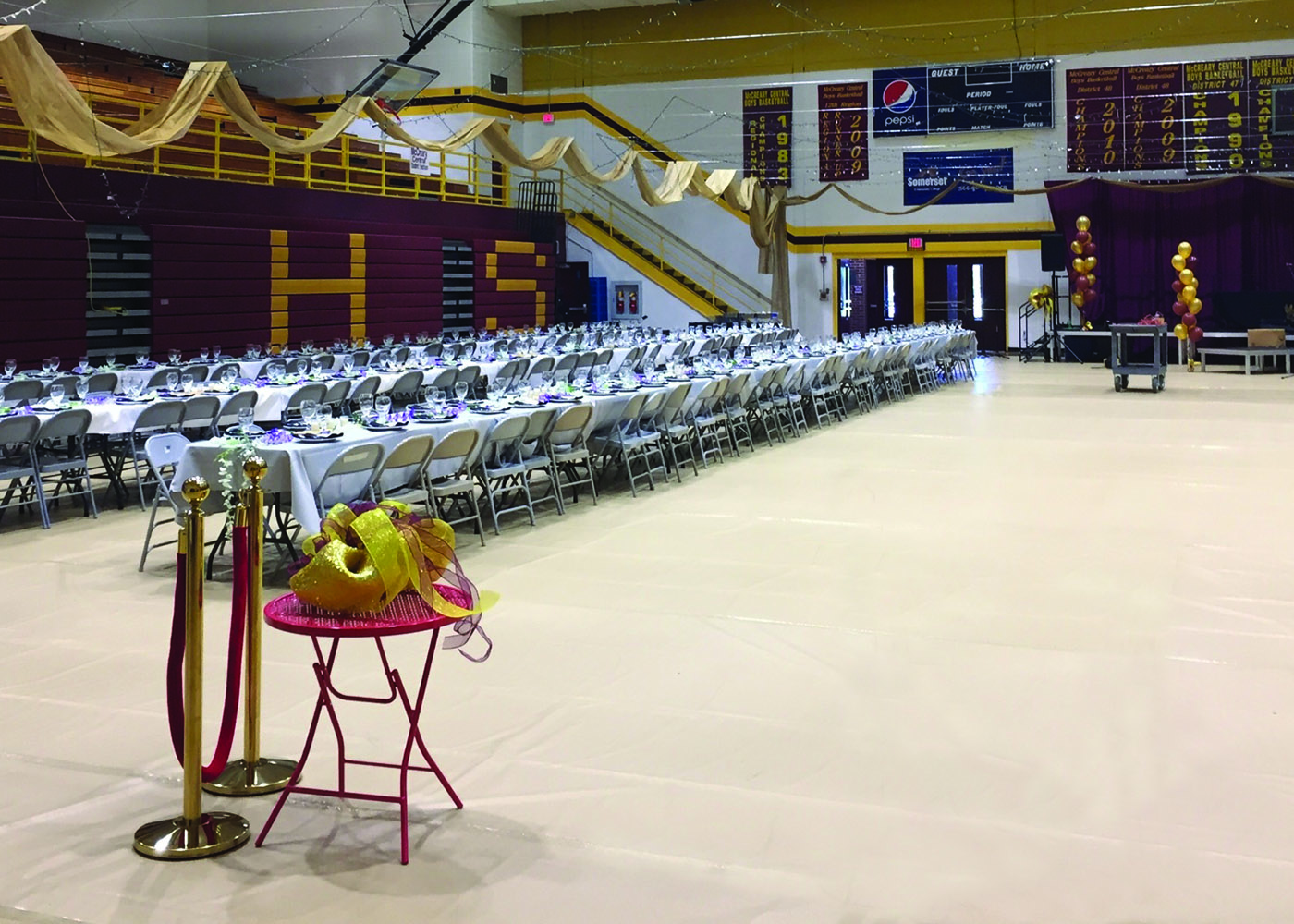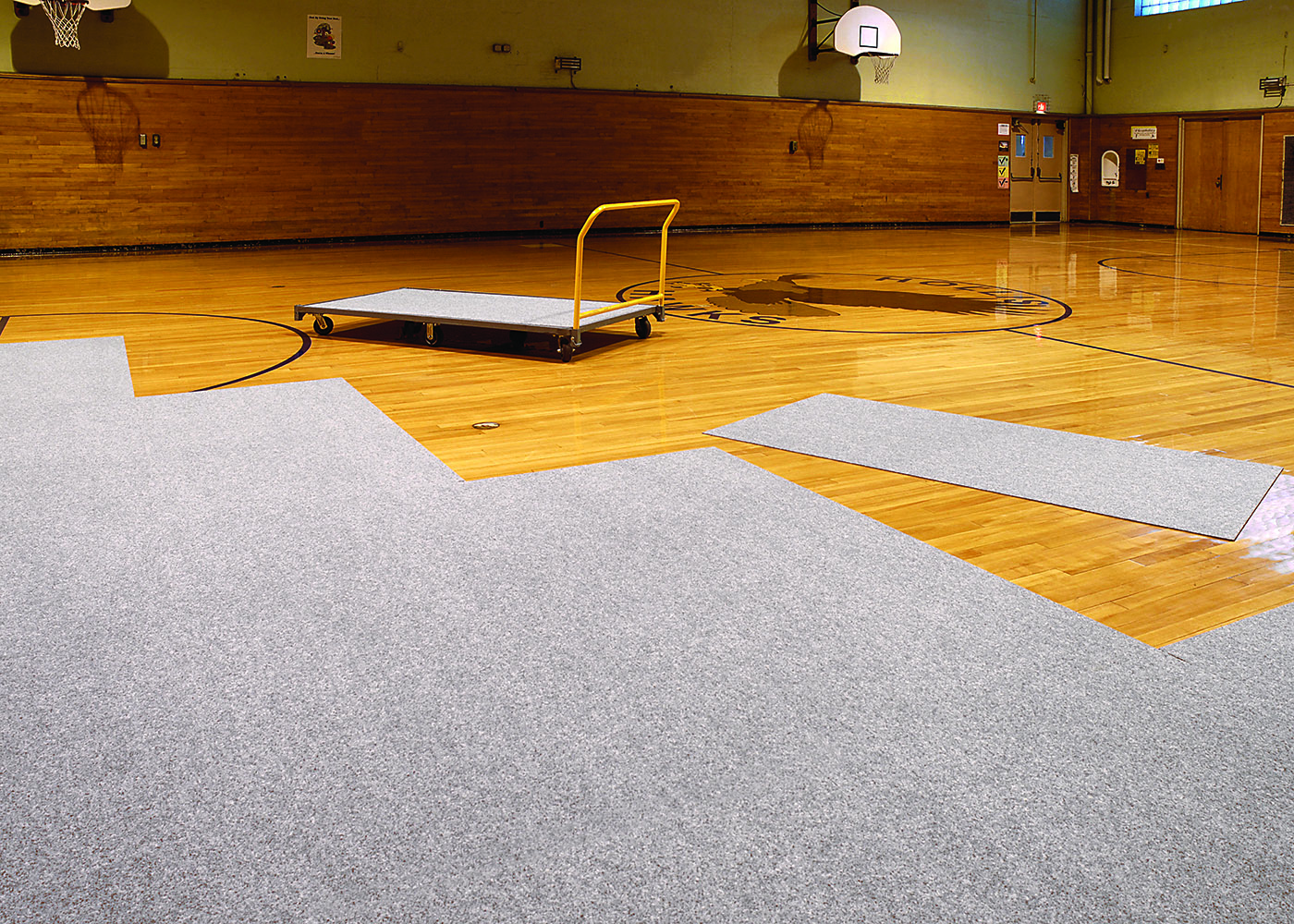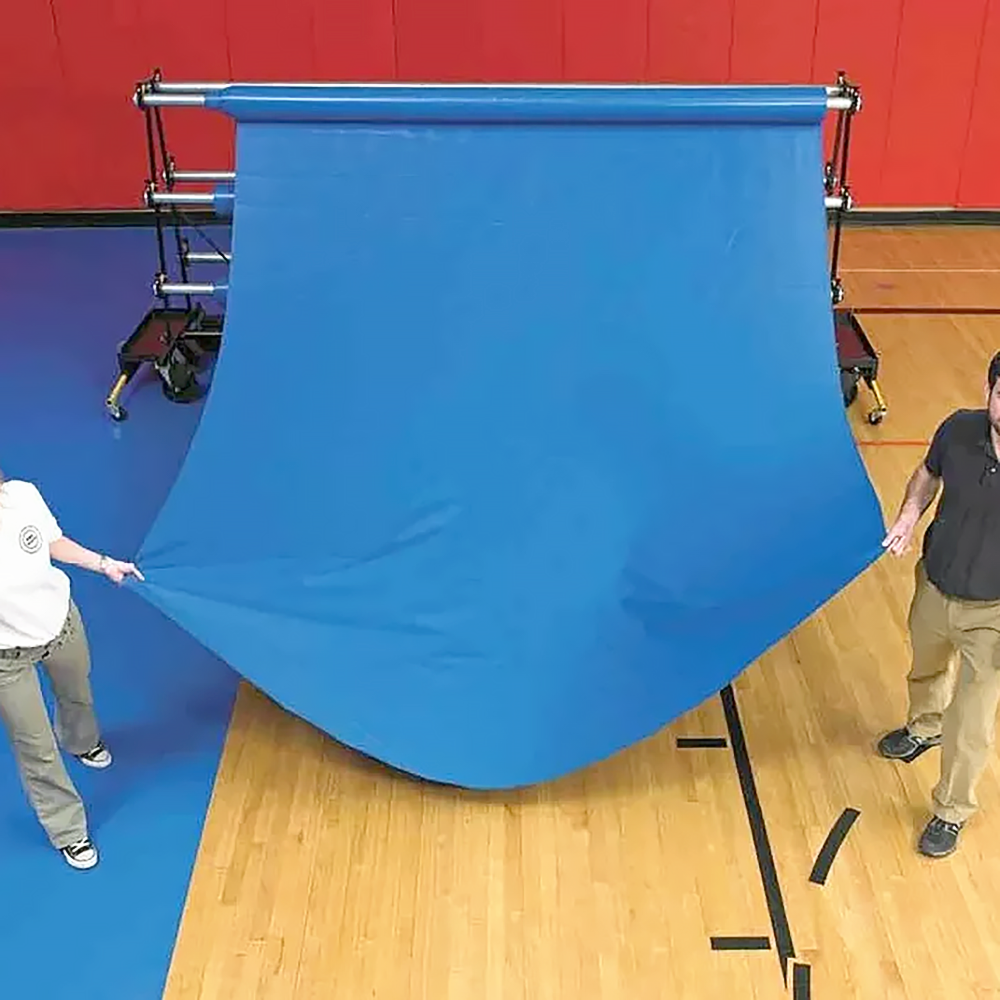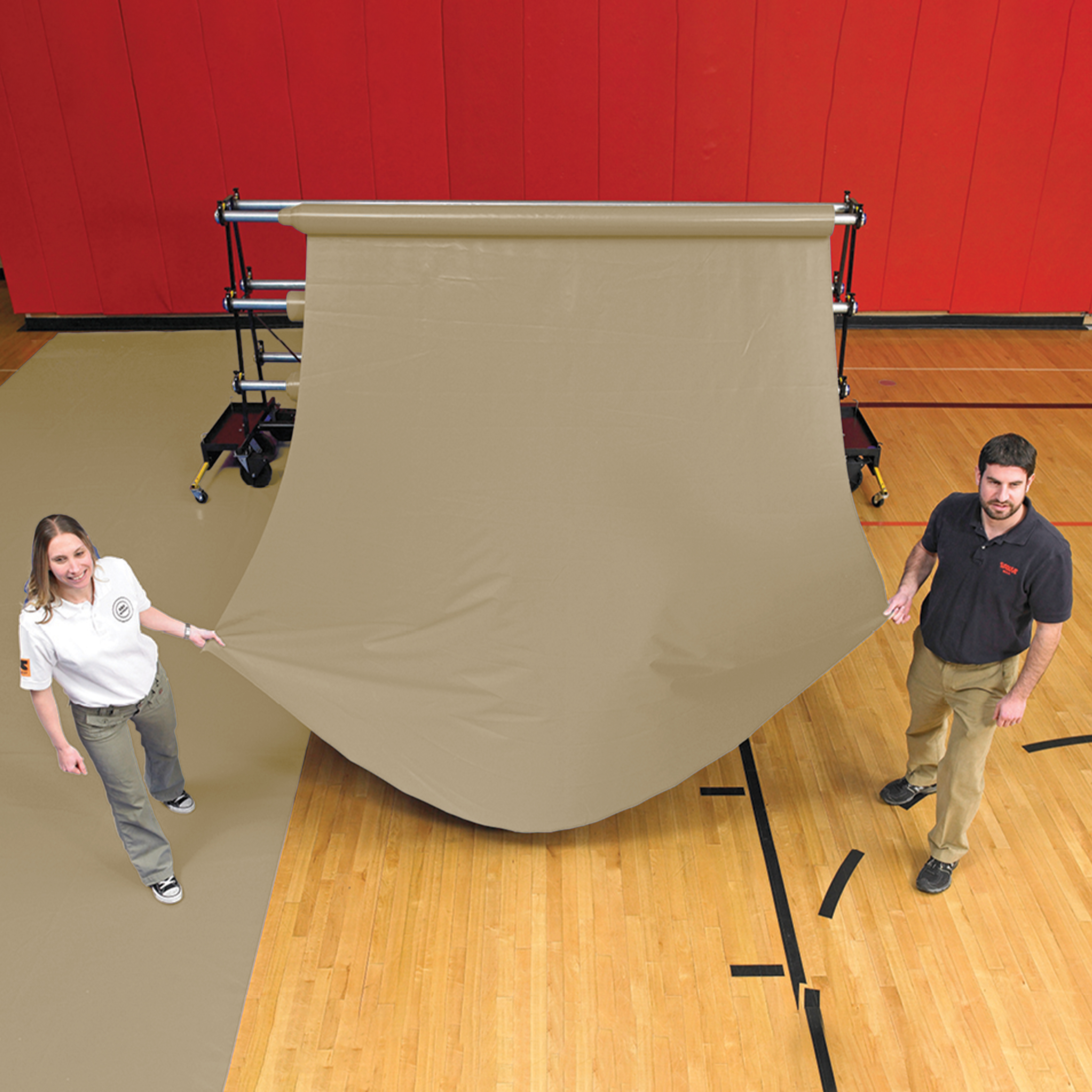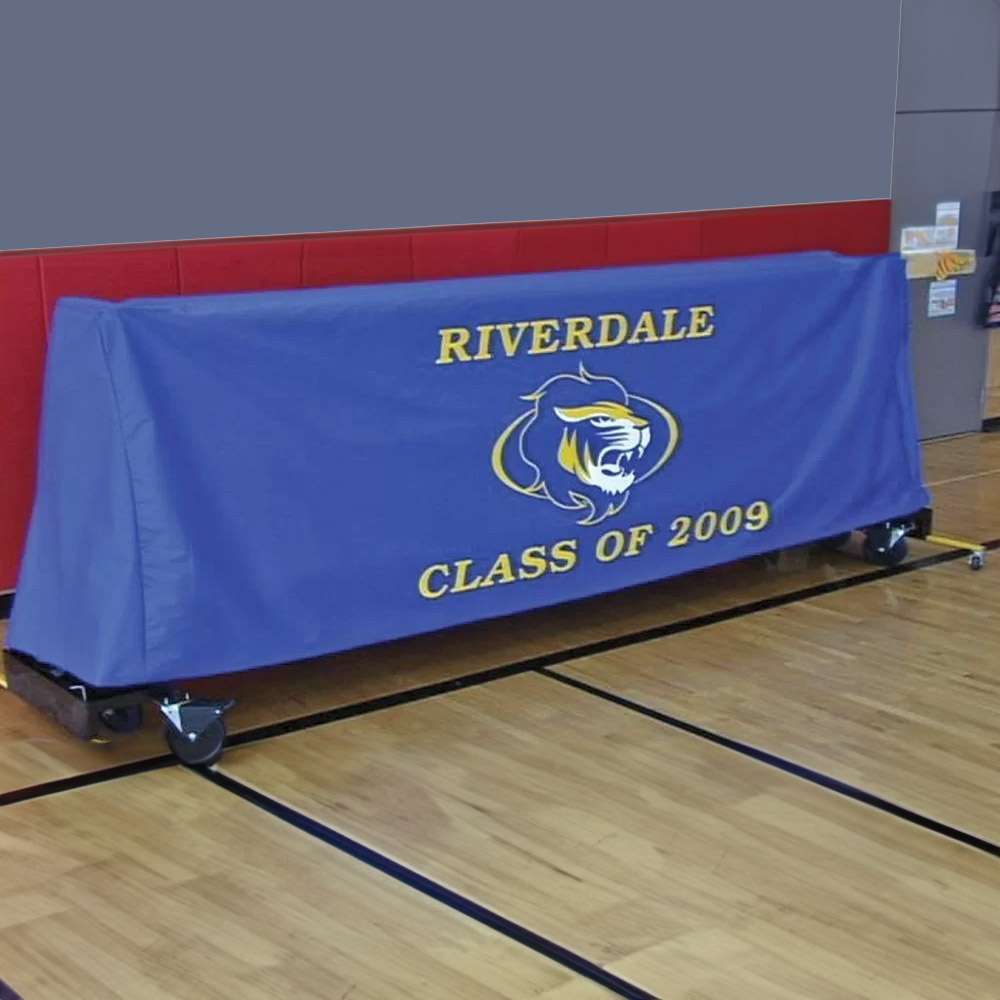Because most gym spaces are used for multiple different activities, it is difficult to limit the amount of damage done over time to a finished hardwood floor. Improper footwear and moving equipment back and forth to convert the use of the space can cause the floor to wear down faster than when used exclusively for athletes wearing tennis shoes or the like. Not only does this affect the look of the floor, but after a certain point, it also damages the effectiveness of the floor and will repeatedly require costly maintenance.
Why You Need a Gym Floor Cover
The cost of repairing or refinishing a gym floor can be substantial, and without preventative measures, damage is not a matter of if but when. Gym floor covers provide a reliable layer of protection that shields the flooring from everything that comes with non-athletic use, including dirt, liquids, heavy furniture, and high-volume foot traffic. During events like school dances or award ceremonies, people may wear street shoes or even high heels that can dent or scuff the floor’s surface. Chairs and tables can leave behind scrapes or indentations, while spills from drinks or food can lead to staining or water damage. By using a high-quality gym floor cover, facility managers can avoid the long-term consequences of these events, reduce the frequency of floor maintenance, and create a safer environment for everyone using the space.
Types of Gym Floor Coverings
There are several different types of gym floor coverings available, each designed to provide varying levels of protection, ease of use, and visual appeal. When choosing the right covering, it is important to consider the type of events your facility hosts, how frequently the gym is used for non-athletic purposes, and the ease with which the cover can be deployed and stored. Some floor coverings prioritize durability and maximum protection, while others are designed for aesthetic presentation and quick installation. Selecting the right floor covering will depend on your unique facility needs and how you plan to balance protection, appearance, and convenience.
Vinyl Floor Covers
GymGuard vinyl floor covers, offered by CoverSports and Baseball Fence Store, are among the most durable and trusted solutions on the market. These heavy-duty vinyl tarps are made from three-ply PVC polyester fabric, engineered to withstand the rigors of heavy use in high-traffic environments. Available in multiple weights ranging from 18 ounces to 32 ounces per square yard, GymGuard covers allow facilities to select the appropriate protection level based on the frequency and intensity of use. For example, a 27-ounce or 32-ounce cover is ideal for gyms that frequently host large-scale events, while an 18-ounce option may be sufficient for occasional coverage needs. These covers are treated to resist fire, mildew, and rot, making them safe and low-maintenance options for schools and recreation centers. They are also available in a variety of colors, allowing facilities to match school branding or event themes with ease.
Shop Vinyl Floor Covers
Carpet Tile and Roll Systems
For events that demand a more upscale or formal appearance, carpet tile or rolled carpet systems provide an attractive alternative to traditional vinyl coverings. These coverings not only protect the gym floor from damage but also offer enhanced aesthetics and comfort. The interlocking tile design makes installation and breakdown straightforward, while rolled carpet systems are great for covering large areas quickly. In addition to their visual appeal, carpet covers also provide slip resistance and sound absorption, which can improve the overall event experience. These features make them ideal for formal events such as graduations, awards nights, or community banquets. While they may not be as rugged as vinyl covers in high-impact environments, their elegant presentation makes them an excellent option for specific use cases where appearance matters.
Shop Carpet Tile Covers
How to use a Gym Floor Cover to its Fullest Ability
Installation and Use
Installing and removing gym floor coverings can be a streamlined process with the right tools and preparation. GymGuard systems are designed with user-friendliness in mind, and facilities can further optimize the process by incorporating accessories such as power winders, hand cranks, and storage racks. Before installation, it is important to clean the gym floor thoroughly to remove dust and debris. Once clean, the cover sections can be rolled out using the storage rack’s central roller bar. Cover seams may be secured with specially designed tape to prevent shifting during use. After the event, the cover is rolled back onto the rack for storage. The entire process is efficient and helps maintain the cover's condition for future use. Facilities with power winders can complete this process even faster, reducing labor and minimizing the risk of injury for maintenance staff. With proper training and organization, a small team—or even a single person—can install and stow a gym floor covering system in a matter of minutes.
Safety and Compliance
In addition to providing protection and aesthetics, gym floor covers must also meet safety standards for public spaces. Many of the covers, including those in the GymGuard line, comply with NFPA-701 fire retardant certification, which is essential for public health and fire safety codes. The slip-resistant texture on these covers helps prevent falls and accidents, even when large crowds are present or when spills occur. This is particularly important during school events, where the safety of students, staff, and guests is a top priority. Using a properly secured and tested floor cover helps mitigate liability and ensures your facility is adhering to all necessary safety regulations.
Customization and Branding Options
Many gym floor covers offer customization features that allow facilities to add logos, names, or other branding elements directly onto the material. This not only adds a sense of professionalism to events but also reinforces school spirit and brand identity. Custom covers can include school colors, mascots, or slogans, transforming a basic protective covering into a visually cohesive part of the event décor. Whether you are hosting a pep rally or an alumni event, having a branded cover elevates the experience and leaves a lasting impression on guests.

Contact Us about YOUR Custom Gym Floor Covering!
Storage and Accessory Solutions
Storing gym floor coverings correctly is essential for preserving their durability and performance. A wide range of storage and maintenance accessories are available to help manage the system effectively. Storage racks, which hold multiple rolls of vinyl covering, provide an organized and compact way to keep covers safe when not in use. These racks often come with wheels, making them easy to move in and out of storage areas. Optional rack covers keep dust, dirt, and debris from settling on the rolled covers, extending their usable life. Power winders can be added to streamline the process of deploying and retracting covers. Brush assemblies are another helpful addition, cleaning the surface of the cover as it is rolled up to avoid trapping dirt in storage. Tape dispensers and rolls of cover tape help secure the covering to the floor, ensuring a tight fit and reducing trip hazards during events. Divider curtains and wall padding are also available to help convert gym spaces into flexible, multi-zone environments, accommodating simultaneous activities without compromising safety or organization.
Shop Storage and Accessories
Contact Us
If you have questions about choosing the right gym floor covering for your facility, we’re here to help. Whether you’re outfitting a new space or upgrading existing equipment, our team can guide you through the best options for safety, durability, and performance. We’re committed to helping you create a safe, functional environment for athletes of all ages and skill levels. Reach out today to get expert guidance or request a quote tailored to your needs.
Contact Us

